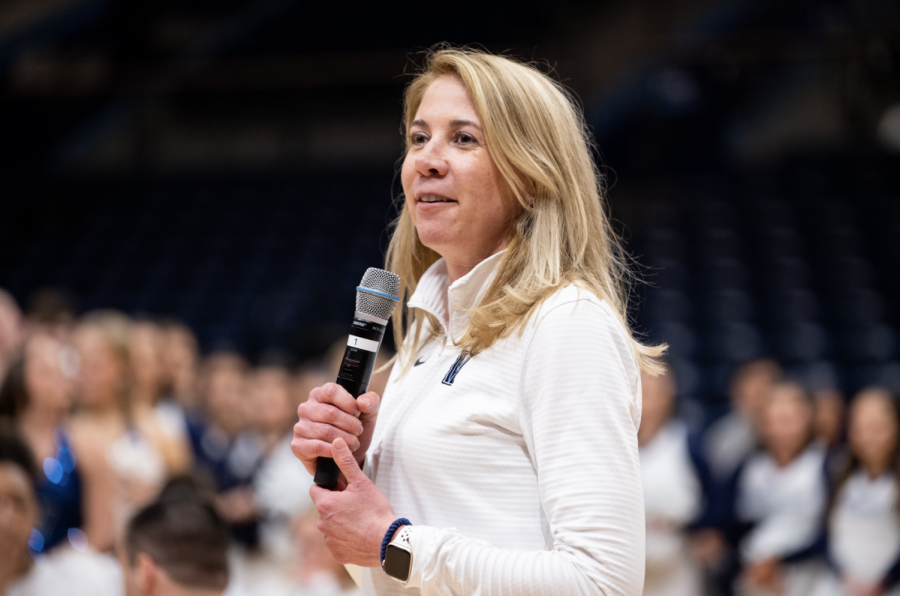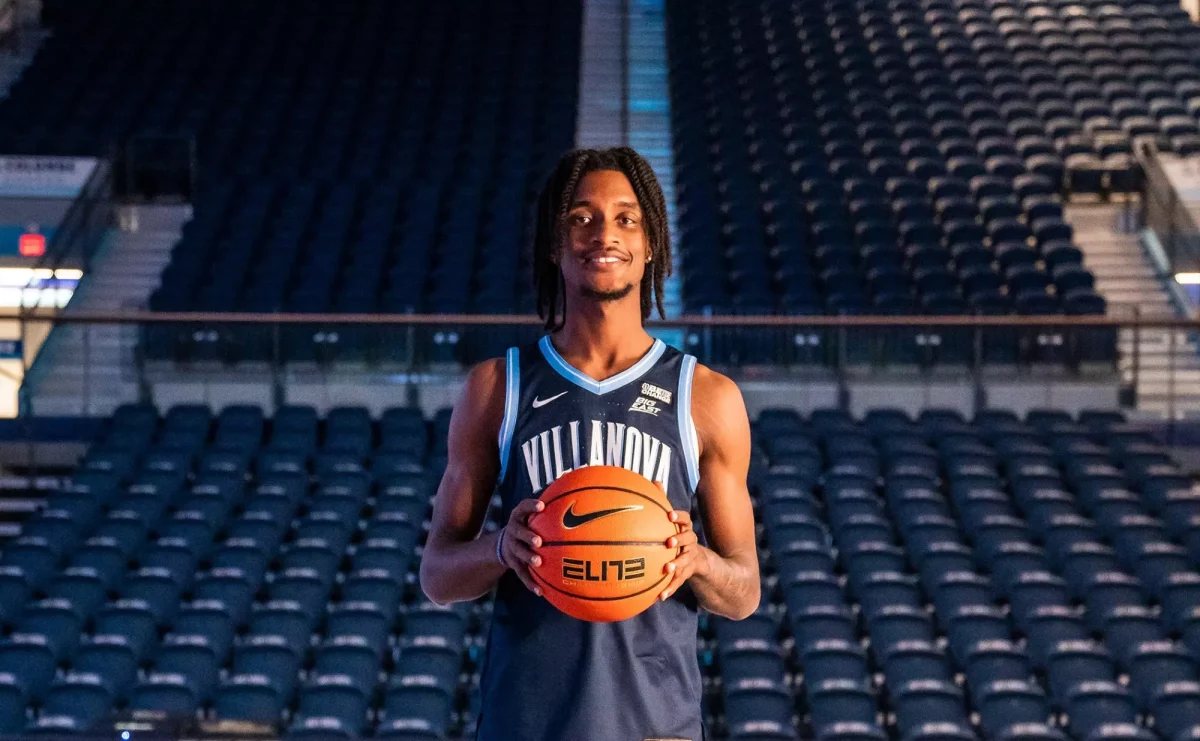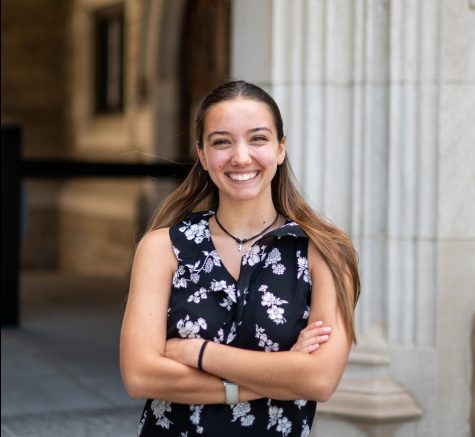When Villanova women’s basketball takes the court in its season opener against Wake Forest on Sunday, Nov. 10, the team will look much different than it did last year.
Former Wildcats Christina Dalce, Lucy Olsen and Zanai Jones all chose to put on other schools’ jerseys for 2024-2025. Dalce is at No. 18 Maryland, Jones is at Southern Methodist and Olsen is at Iowa, as the Hawkeyes look to replace the prolific scoring of WNBA Rookie of the Year Caitlin Clark.
In the new era of name, image and likeness (NIL) and the transfer portal, losing star players to other schools has become almost inevitable for most college basketball programs. Many coaches, including Villanova head coach Denise Dillon, have had to accept the reality of players leaving for other teams, even when it is unexpected.
“‘You never anticipate players exiting… especially that far into their time here at Villanova, academically standing and athletically,” Dillon said. “The truth of it is you focus on the present. I think that’s the one lesson we learned. Don’t project too far out. Pivot is a great term. We certainly did that in the spring and brought in some high caliber players and greater people.”
The 2023-24 roster had 14 players. In the days following the team’s season ending loss in the WBIT championship game in April, six Wildcats entered the transfer portal. Olsen was the first, with reports of her decision surfacing April 9.
In addition to Dalce, Olsen and Jones, sophomore forward Megan Olbrys, redshirt freshman guard Abby Jegede and senior forward/center Kylie Swider also left the program. The ‘Cats also lost guard Bella Runyan, who graduated.
In her senior season, Runyan was one of the team’s most important players as a high-intensity perimeter defender. Olbrys had become an important role player and someone who always provided a spark off the bench. Jones had been a starter and one of the team’s primary ball handlers. Olsen averaged 23.3 points per contest as the top offensive option for the ‘Cats.
When asked what was behind all the departures, Dillon emphasized that there was not a collective reason. All six players who transferred had different reasons for choosing to finish their college careers elsewhere.
“Every situation was unique to its own,” Dillon said. “Zanai Jones graduated, so she was looking to go. Two younger players, Megan and Abby, were just looking for different geography… [and] one went closer to home. So it’s not for one reason or the other.”
The notable players who stayed include senior guard Kaitlyn Orihel, graduate guard Maddie Burke and sophomore guard Maddie Webber. All three players are expected to fill the void left by Dalce, Olsen, Jones and Runyan.
“We’ve been fortunate to have some veteran players like Kaitlyn Orihel [and] Maddie Burke,” Dillon said. “Even Denae Carter, coming back from injury, but being familiar with what we’re doing, has been refreshing because they have that understanding of what it takes to be successful.”
The unexpected losses forced Dillon and her staff to reconstruct their team and the program as a whole. The loss of leading scorer Olsen and leading rebounder Dalce left a lot of production for the Wildcats to replace.
Fortunately for Villanova, Dillon wasted no time recruiting players from the portal.
By the end of the summer, Dillon had landed several transfers to go along with the key returners. She also welcomed her 2024 recruiting class, which included three freshmen.
The transfers included senior guard Jaliyah Green from Southeast Missouri State, junior guard Ryanne Allen from Vanderbilt, graduate guard Bronagh Power-Cassidy from Holy Cross and graduate forward Lara Edmanson from Santa Clara.
The 2024-25 team spent the summer practicing and getting to know one another, but the work officially began earlier this month.
“We’re three weeks in, so you can see each practice that this group is getting more comfortable playing together,” Dillon said. “We were really fortunate to have our foreign tour back in August in Italy. That time together really expedited the chemistry of getting to know each other off the court and having some games on the court.”
The 2024-25 season will also mark the end of “the COVID year.” The NCAA’s decision to grant athletes affected by the pandemic shortened 2019-20 season an extra year of eligibility is the reason why many players have been able to come back to school for a fifth or sixth season. Even with the end of the extra year, the transfer portal is expected to play an even bigger part in teams’ off-seasons going forward. Dillon will continue to utilize the portal on a season to season basis.
“I think it’s a different situation each year,” Dillon said. “I’m not going to approach this season or the next thinking I’m going to lose two or three [players] you’re figuring out what this looks like in the big picture of how the NCAA’s running it and most importantly how things are being run here at Villanova.”
Before the NCAA changed its rules regarding transfers during the pandemic, players who transferred were required to redshirt an entire season before being able to play for a new team. In 2024, players can transfer and are immediately eligible to play.
The old rule prevented many players from transferring to other schools. Before COVID there was far less movement than there was today. The new rule means players do not miss an entire season. This has many benefits such as allowing players to develop more quickly. It also has a number of downsides such as its effect on programs who have built a certain culture or identity.
 Analysts and fans have often compared college basketball’s transfer portal to the free agency that exists in the professional leagues. Player movement is now the reality of college basketball and something that Dillon and the Villanova program must deal with.
Analysts and fans have often compared college basketball’s transfer portal to the free agency that exists in the professional leagues. Player movement is now the reality of college basketball and something that Dillon and the Villanova program must deal with.
Despite seeing a new season ticket record, more interest from the student body and being well supported by the University, Villanova women’s basketball still lost its two best players in Olsen and Dalce. These players transferred to schools whose teams are regularly televised and consistently playing in the NCAA Tournament.
Villanova was hit particularly hard by player movement, retaining 28% of its scoring output from last season. However, Villanova is not the only program dealing with retaining players. Oregon State, Stanford and Michigan all lost their leading scorers from 2023-24 to the portal. Those schools, including Villanova, have turned to the portal themselves and created teams hungry to compete in their respective conference.
Dillon has replaced Olsen and Dalce with experienced college players who are already making their impact on the court, in the classroom and in the community. Power-Cassidy averaged 18.6 points in her senior year at Holy Cross, leading the Crusaders to a Patriot League title. Green averaged 12.9 for Southeastern Missouri State. Edmanson posted 7.7 a night for Santa Clara on 53.9% shooting from the field. Allen appeared in 30 games for Vanderbilt as a sophomore.
“It’s their maturity factor,” Dillon said. “These are players who have had experience elsewhere but first and foremost just being natural leaders because of who they are as people and their foundation and their upbringing within their families has been refreshing and an area we haven’t really needed to hone in on. They’re taking care of business off the floor and it’s up to use to help them on the floor be the best team we can ”
This year’s team looks different. It is not a Villanova team of the past, but it is a reflection of the current era of college basketball. Some are freshmen, some are transfers and some are veterans.
With this combination it’s clear that Dillon is trying to build a team who can compete for championships and qualify for the postseason. It has not always been easy but it is something that has needed to be done and something that will help preserve the tradition of the program.







